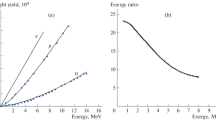Abstract
The momentum spectrum of annihilating positron-electron pairs is normally analysed in terms of two or more momentum groups. If the medium is heterogeneous, or if it permits the formation of positronium, the annihilation time spectrum also becomes complex with as many as four resolvable exponential components. The interrelationship of these groups is difficult to establish because the usual measurements of time and momentum spectra are done with instruments of low absolute efficiency. We have made simultaneous measurements of time and energy spectra using a Ge(Li) spectrometer as a momentum analyser, obtaining an approximate hundredfold increase in data output at a cost of a factor of 3 in momentum resolution.
The momentum spectrum of the intermediate lifetime component in a plastic scintillator is shown to be very similar to that of the long-lived orthopositronium. Recent developments in fast timing and in high purity Ge detectors should improve both the quality and quantity of data from these techniques, making them feasible for routine studies of polymers, chemical solutions and metallic voids.
Similar content being viewed by others
References
R. E. Bell, R. L. Graham: Phys. Rev.90, 644 (1953)
R. L. Graham, A. T. Stewart: Can. J. Phys.32, 678 (1954)
A. T. Stewart: Phys. Rev.99, 594 (1955)
R. L. DeZafra, W. T. Joyner: Phys. Rev.112, 19 (1958)
I. Spirn, W. Brandt, G. Present, A. Schwarzchild: Bull. Am. Phys. Soc.9, 394 (1964)
A. W. Sunyar: Bull. Am. Phys. Soc.9, 394 (1964)
S. J. Tao, J. H. Green: Proc. Phys. Soc.85, 463 (1965)
W. Brandt, I. Spirn: Phys. Rev.142 231 (1966)
J. D. McGervey, V. F. Walters: Phys. Rev. B2, 2421 (1970)
J. R. Stevens, P. C. Lichtenberger: Phys. Rev. Letters29, 166 (1972)
F. H. H. Hsu, C. S. Wu: Phys. Rev. Letters18, 889 (1967)
R. M. J. Cotterill, I. K. MacKenzie, L. Smedskjaer, G. Trumpy, J. H. O. L. Traff: Nature239, 101 (1972)
I. K. MacKenzie, B. T. A. McKee: Bull. Am. Phys. Soc.12, 687 (1967)
B. Bengtson, M. Moszynski: Nucl. Instr. Meth.100, 293 (1972)
Z. Bay: Phys. Rev.77, 419 (1950)
N. Thrane: Private Commun. Much of the effect may be due to small angle scattering in source and sample
We find that the operating resolution function in large scintillators is much broader than that measured by60Co, introducing a severe limit on accurate deconvolution of time spectra
Author information
Authors and Affiliations
Rights and permissions
About this article
Cite this article
MacKenzie, I.K., McKee, B.T.A. A two-parameter measurement of the correlation of positron age with the momentum of the annihilating positron-electron pair. Appl. Phys. 10, 245–249 (1976). https://doi.org/10.1007/BF00897223
Received:
Accepted:
Issue Date:
DOI: https://doi.org/10.1007/BF00897223



